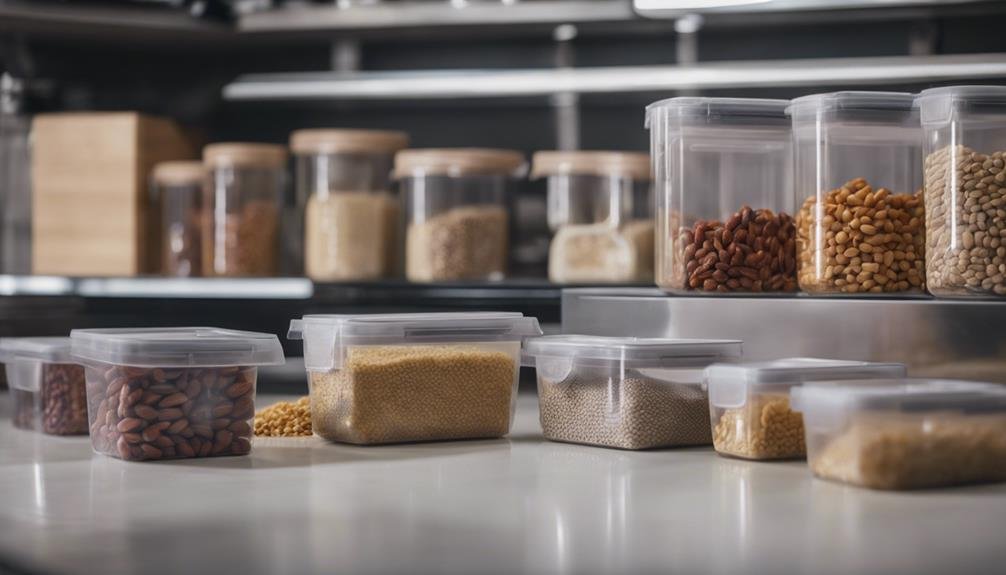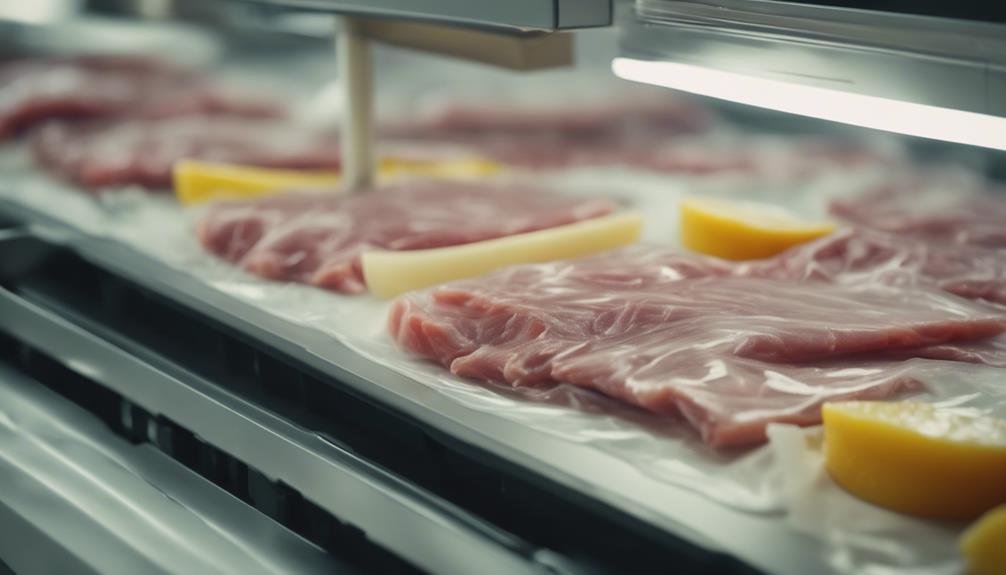Vacuum sealing methods vary depending on the type of food you're preserving. Fresh produce like fruits and vegetables can maintain their color and crispness through blanching before vacuum sealing. Meats and poultry benefit from vacuum sealing to prevent freezer burn and extend their shelf life. Dry goods such as coffee and nuts can stay fresh longer by keeping out moisture and pests. Delicate items should be handled with care, using lower pressure or pre-freezing to maintain their shape. When sealing liquids, it's best to pre-freeze them to avoid spills, or consider using vacuum-sealing containers. Each technique ensures your food remains fresh and full of flavor for extended periods. To optimize your vacuum sealing approach, tailor your method to the specific food type you're preserving.
Vacuum Sealing Fresh Produce
Vacuum sealing fresh produce protects your fruits and vegetables from oxidation, extending their shelf life substantially. By using vacuum packaging, you can preserve the freshness and nutrients of various types of food, from summer berries to winter vegetables like broccoli. This method of food preservation is particularly effective for green beans, which can retain their crispness and vibrant color when properly vacuum sealed.
When you vacuum seal your produce, it's important to prepare certain vegetables, such as cabbage, broccoli, and asparagus, by blanching them first. Blanching helps in color retention and enhances the overall quality of the vacuum-sealed food. You'll notice that these vegetables maintain their texture and taste better than those stored through traditional methods.
Vacuum sealing food isn't just limited to vegetables; fruits also benefit greatly from this technique. For example, sealing berries can prevent them from becoming mushy and extend their usability. Additionally, various types of dry goods can be vacuum sealed to protect them from air and moisture, ensuring they remain fresh for longer periods.
Techniques for Meats and Poultry
Sealing meats and poultry not only prolongs their shelf life but also locks in essential flavors and nutrients. By using vacuum sealers, you can keep your meats and poultry fresh for up to three years in the freezer. This food preservation technique is effective because it removes air, thereby preventing freezer burn and food spoilage.
Here's a quick guide for vacuum sealing meats and poultry:
| Step | Action | Benefit |
|---|---|---|
| 1 | Select fresh, high-quality meat | Guarantees best flavor and texture |
| 2 | Pre-freeze for 1-2 hours | Prevents juices from being extracted |
| 3 | Use vacuum sealer to remove air | Reduces risk of freezer burn |
| 4 | Label and date each package | Helps with inventory management |
| 5 | Store in the freezer | Extends shelf life up to 3 years |
Properly sealed meats and poultry retain their flavor, texture, and nutritional value. Vacuum sealed food is also perfect for quick and efficient marinating, as the lack of air lets marinades penetrate deeply. Plus, with this method, you can organize and store different cuts effectively, making meal prep a breeze. So, if you're looking to protect your investment and enjoy delicious, long-lasting meats and poultry, vacuum sealing is the way to go.
Preserving Dry Foods

When it comes to preserving dry foods, you'll find that eliminating air contact is key to maintaining their freshness and flavor. Vacuum sealing dry goods like coffee, nuts, and pasta guarantees they stay fresh by removing the air that can cause them to go stale. Using a vacuum bag, you can effectively lock out moisture and pests, which helps to preserve food quality for much longer periods.
By vacuum sealing, you can also prevent your cereals and spices from losing their aroma or developing unwanted odors. This technique not only keeps your dry goods in prime condition but also helps you organize your pantry efficiently. No more half-opened packages cluttering your shelves!
Additionally, vacuum sealing is an excellent way to reduce food waste. When dry foods are properly sealed, they have a notably extended shelf life, allowing you to use them at your convenience without the worry of them going bad. You'll save money and reduce the amount of food you throw away.
In essence, vacuum sealing your dry goods is a straightforward and effective way to preserve food, maintain flavor, and keep your pantry organized and free of food waste.
Handling Delicate Items
Handling delicate items like berries and baked goods requires careful attention to pressure settings to prevent damage. When using a vacuum sealer, it's important to adjust the pressure to a lower setting. This helps avoid crushing the food and guarantees its integrity. For pressure-sensitive foods, consider vacuum packing them in containers instead of bags. Containers provide a gentler environment, reducing the risk of damage.
To further protect delicate products that go on your shelf, like pastries or soft fruits, you might want to pre-freeze them. Freezing helps maintain their shape during the vacuum sealing process. Once frozen, they can be vacuum packed without the risk of being squished. This method also extends their shelf life significantly.
If you're handling baked goods, placing them on a tray and using a vacuum sealer with a pulse function can be beneficial. The pulse function allows you to control the vacuum pressure manually, ensuring the baked goods aren't flattened. Remember, the key to successfully vacuum packing delicate items is to monitor the pressure closely and use the appropriate settings. By doing so, you can extend the shelf life of these sensitive food items without compromising their quality.
Managing Liquids and Moist Foods

Managing liquids and moist foods in vacuum sealing demands a few specialized techniques to guarantee a mess-free and effective process. When dealing with vacuum-sealed food, it's important to adopt methods that prevent spills and secure a reliable seal. Here's how you can tackle liquids and moist foods effectively:
- Freeze Liquids First: Freezing liquids like soups or sauces before vacuum sealing can prevent spills and ease the sealing process.
- Higher-End Vacuum Sealers: Investing in a vacuum sealer with a liquid detection feature ensures that the machine handles liquids more efficiently.
- Separate Pre-Sealing: Seal liquids in a separate bag before vacuum sealing to control moisture and simplify the process.
- Leave Space at the Top: Always leave enough space at the top of the bag to accommodate the liquid and ensure a proper seal.
- Use Containers: Vacuum sealing liquids in containers can prevent leakage and help maintain freshness.
Conclusion
Imagine opening your pantry to find vibrant, crisp vegetables, juicy cuts of meat, and perfectly preserved dried foods, all thanks to your vacuum sealing skills. By mastering these techniques, you've secured that your meals are fresh and flavorsome. Picture delicate berries staying intact and soups stored without spills. You've discovered a new level of food preservation, making your kitchen a haven of convenience and deliciousness. Enjoy the fruits of your labor, literally and figuratively!
